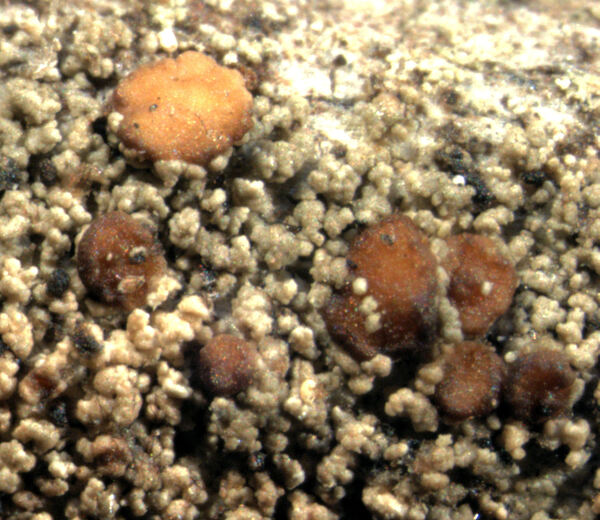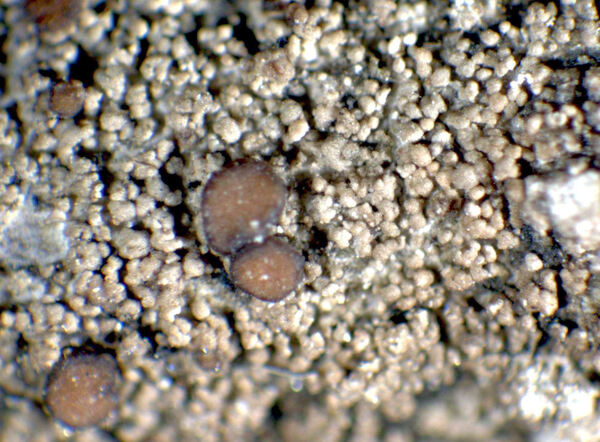Myochroidea leprosula (Arnold) Printzen, T. Sprib. & Tønsberg
Lichenologist, 40: 198, 2008. Basionym: Biatora leprosula Arnold - Lich. Exs.: 545, 1874.
Synonyms: Lecidea leprosula (Arnold) Harm.
Distribution: N - Frl (Hinteregger 1994, in Austrian terr., near the border).
Description: Thallus crustose, episubstratic, grey to grey-brown, of densely crowded, 0.05-0.15 mm wide, strongly convex, often slightly crenate to subcoralloid, isidia-like areoles. Apothecia biatorine, round to slightly irregular in outline, sessile with a constricted base or more rarely appressed, 0.3-0.8 mm across, with a ochre, orange-brown or red-brown, flat to slightly convex, sometimes thinly whitish-pruinose (only visible when wet) disc, and a distinct, but not prominent, finally often excluded proper margin. Proper exciple brown and with minute colourless granules in outer part, colourless or pale yellow within, laterally 40-100 μm thick, of densely entangled, branched and anastomosing hyphae with slightly thickened and pigmented apical cells; epithecium to 25 μm high, pale ochre to reddish brown, with colourless to pale ochre granules, K-, N+ bright orange-brown, sometimes streaking into the hymenium; hymenium colourless, 60-75 μm high; paraphyses relatively easily separated, sparingly branched and anastomosing, 0.7-1.5 μm thick, the apical cells to 2 μm wide; hypothecium colourless to yellowish, 70-150 μm high. Asci 8-spored, cylindrical-clavate, the I+ blue tholus with a wide, I+ dark blue tube structure that expands towards the top, without a pale axial body, approaching the Micarea-type. Ascospores 1-celled, hyaline, broadly ellipsoid, 9.5-15.5 x 4-8 μm. Photobiont chlorococcoid. Spot tests: thallus K-, C-, KC-, P-. Chemistry: 2 fatty acids.Note: a circumboreal species growing on twigs of subalpine shrubs, certainly more widespread in the Alps.
Growth form: Crustose
Substrata: bark
Photobiont: green algae other than Trentepohlia
Reproductive strategy: mainly sexual
Commonnes-rarity: (info)
Alpine belt: absent
Subalpine belt: extremely rare
Oromediterranean belt: absent
Montane belt: extremely rare
Submediterranean belt: absent
Padanian area: absent
Humid submediterranean belt: absent
Humid mediterranean belt: absent
Dry mediterranean belt: absent

Predictive model
Growth form: Crustose
Substrata: bark
Photobiont: green algae other than Trentepohlia
Reproductive strategy: mainly sexual
Commonnes-rarity: (info)
Alpine belt: absent
Subalpine belt: extremely rare
Oromediterranean belt: absent
Montane belt: extremely rare
Submediterranean belt: absent
Padanian area: absent
Humid submediterranean belt: absent
Humid mediterranean belt: absent
Dry mediterranean belt: absent

Predictive model
 Index Fungorum
Index Fungorum
 GBIF
GBIF





